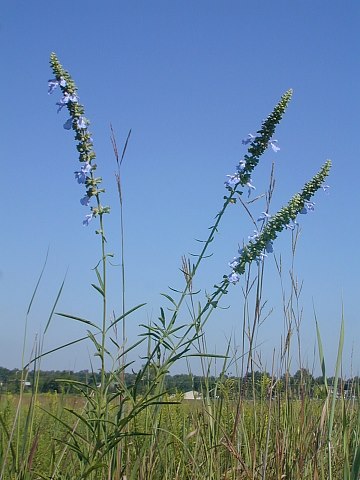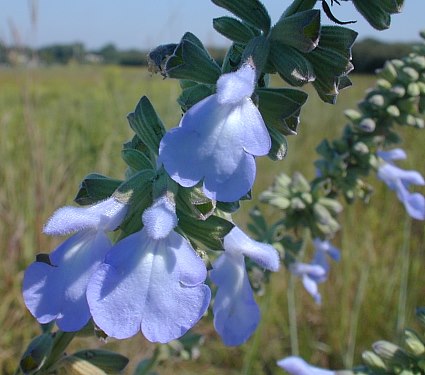Description: This perennial plant is 2½-5' tall; it is unbranched, or with a few small stems near the inflorescence. The central stem is ridged and slightly pubescent. The opposite leaves are greyish green, narrowly lanceolate, with serrated or dentate margins toward their tips. They are about 3-5" long and ¾" wide, becoming linear and shorter near the inflorescence. The foliage exudes a sage scent and has a sage taste.

There is one or
more whorled spikes of flowers toward the apex of the plant that are up
to 1' long. The corolla of these flowers ranges in color from pale blue
to deep dark blue, usually with a lighter-colored throat. The corolla
is short and tubular, dividing into a small upper lobe and a large
lower lobe that functions as a landing pad for visiting insects. The
tubular calyx is dull green, longitudinally ridged, pubescent, and
bluntly toothed. Each flower is about ¾" long from top to bottom. The
blooming period occurs during the late summer and fall, and lasts about
1-2 months. There is no floral scent. Only a few flowers are in bloom
at the same time. The root system consists of a large central taproot,
from which several stems may be produced.
Cultivation:
The preference is full sun and dry, well-drained conditions. Different
kinds of soil are acceptable, including those that contain significant
amounts of loam, clay, or gravel. A high pH is tolerated. The seed
germinates readily, often producing flowering plants during the first
year. This is a surprisingly easy plant to grow, with few problems from
disease. If the soil is too moist and fertile, or sunlight is
insufficient, plants may become spindly and flop over while blooming
later in the year.

Habitat & Range:
Wild Blue Sage is a rare plant in Illinois with state-listed
'threatened' status. It has been reported from only a few scattered
counties, primarily in central and southern Illinois (see Distribution
Map). Some authorities assume that this plant is adventive
from the west, while others regard
it as native to the state. Habitats include dry, upland areas of
black soil prairies, gravel prairies, limestone glades, roadsides, and
miscellaneous waste areas. This plant would likely thrive in dolomite
prairies and hill prairies, although it has not been observed in such
areas.
Faunal Associations:
Long-tongued bees visit the flowers for nectar, especially bumblebees.
Halictid bees occasionally collect pollen, but they are
non-pollinating. Less often, butterflies and skippers may visit the
flowers for nectar, including Epargyreus clarus
(Silver-Spotted Skipper). The caterpillars of the moth Sphinx
eremitus (Hermit Sphinx) may feed on the foliage. Mammalian
herbivores usually avoid this plant as a food source – apparently they
dislike the sage scent, or perhaps the scent is associated with
indigestion from chemicals that disrupt bacterial populations in their
digestive tracts.
Photographic Location:
The photographs of the flowering plant and flower close-up were taken
at Meadowbrook Park, Urbana, Illinois, while the photograph of the leaf
was taken at the wildflower garden of the webmaster in the same city
and state.

Comments: This is a wonderful plant with attractive blue flowers – a pleasant alternative to the preponderance of goldenrods and asters during the fall. It can be confused with no other plant within the state. Wild Blue Sage is more common in states that lie west of the Mississippi River, such as Nebraska and Missouri. In Illinois, only small remnant populations exist. A different variety occurs in some southeastern states, Salvia azurea azurea, which has less showy flowers. In the past, the scientific name for Salvia azurea grandiflora was Salvia pitcheri, and it is still referred to as Pitcher's Sage by some authorities.